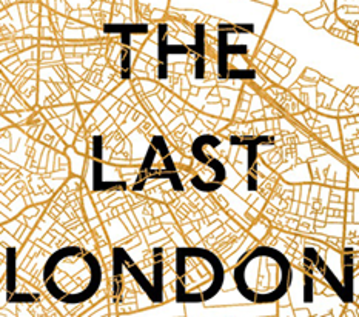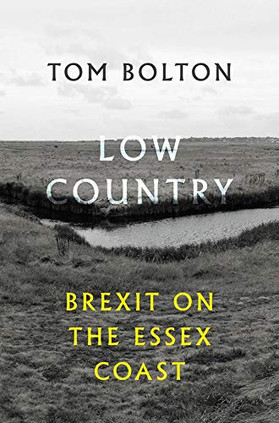
Tom Bolton - Low Country: Brexit on the Essex Coast
Posted in Reading on Sunday 4th November 2018 at 2:11pm
I first encountered Tom Bolton's writing through two small but rather wonderful books, both about aspects of London which fascinated me. The first of these surveyed the familiar territory of the 'lost rivers' - a subject which I've happily wittered about for years to anyone who'd willingly listen, and to many who wouldn't too. Tom's book was well-written, often surprising and perhaps best of all, packed with detail - three things which haven't been true of many of the numerous books on this subject aside perhaps from Nicholas Barton's early and definitive work. Tom's focus on loss continued as he moved on to write about the entire districts which London has managed to carelessly unmap over the centuries of its fractious, ever-reforming existence. Whole locales which were one notable or notorious, but are now preserved perhaps only in a street-name or a pub sign left behind by the pace of social or economic change. Bolton's work delights in sharing this secret knowledge, it is entirely generous, and never glib or pompous. This is expansive, accessible and democratic writing about place. These qualities are, in my experience - and indeed in my own attempts to write on some of these topics - remarkably rare.

In this new and somewhat more personal effort, Bolton writes about a journey around the ragged and marginal coastline of Essex. That alone would have attracted me to this book, but doing so at this intemperate and disrupted time makes it all the more compelling - his subtitle is an additional hook. He and his partner divided the epic coastal walk into weekend-sized adventures, gradually progressing around the shifting and often ill-defined landfall of the eastern edge of Britain while the country disintegrated from within. Carefully edging around the curiously unpeopled but ever industrious dumping grounds of the Thames Estuary, or navigating the starkly empty reaches of mud and shifting sands on the North Sea coast, they plot a course rarely walked. Indeed its a course which may not remain possible for long as the scouring waters of the sea reclaim inches of coastline, feet of cliff-face and wide expanses of low-lying saltmarsh with each new stormy season. The path on their map is sometimes a memory before they even reach it, and almost certainly both the country and its fabric will be changed forever by the time one reads this book. As Tom and Jo work their way around the coast, they are drawn into the history and literature of the place - often unexpectedly and sometimes unwillingly encountering an Essex narrative which appears utterly different from the one sold on reality TV and accepted lazy into the zeitgeist.
But what of Brexit? Is it simply the case that getting any journey-related book published nowadays is significantly more likely if it somehow promises to take the pulse of a divided nation as the perambulation takes place? In this case, not so. The underpinning ideas of Brexit: unbridled freedom, set-in-stone (small C) conservatism and the cosy protectionism of Empire, are woven into the fabric of Essex in a much deeper sense than some other areas. Even others where the Leave vote loomed largest as it did here. Some of the places which Bolton visits have little connection to London, let alone Brussels. Railways severed, wharves decommissioned and roads often impassable due to flooding, these zones are self-contained and shun external influence. As the path along the sea defences edges further out and eventually disappears into shifting salt marshes, it seems more and more natural that these areas wanted out of the EU. They are connected with nothing, let alone something which seems, even conceptually, utterly distant from the experience of life on the very edge of the Kingdom. At one point, as Bolton shuffles through drowsy, hungover Jaywick - somewhere which ought to be kicking and screaming for any source of funding - the lack of shacks festooned in Vote Leave publicity is a surprise. But of course, it shouldn't be. It's simply assumed that you don't need to be persuaded here. Leave is a natural, unchallenged response. The landmass, drowned and murky though its borders are, has been repelling all-comers for generations. Let's just make that official.
Throughout Low Country, Bolton's topographical writing is beautiful and evocative but carries an architects' precision in its expression. The monotony and alien same-ness of the sands and mudflats ought to lie beyond easy description, but he has new observations and new intonations for each of the subtle shifts he finds as land gives way to estuary and imperceptibly becomes ocean. There are few people to be found out here, but those who appear are written as the kind of brief, flickering ghost-presences which I too have met on lonely paths through the marshes. In that sense alone, the book is an essential read - this journey which few of us will take deserves to be recorded. It has a heritage in the tradition of landscape authors who once regarded Essex as worthy of note and recognised its surprising difference to England at large. But Bolton's book goes beyond a description of the terrain, and somehow gets under the skin of Essex while it does the same to him in return. In the closing section, where he walks the treacherous Broomway over Maplin Sands and the expansive, reflected mud flats become inseparable from the sky, he captures something essential of the Essex coast and its liminality. Later, he experiences for the first time a newly developed allergy to pollen - the marshes have returned his attention with interest.
There are commonly thought to be two distinct tribes in the UK just now, and we are all required to identify vigorously and loudly as Leaver or Remainer. This does us all a disservice - we're more complicated than that and deserve to be listened to fully and fairly. We're all a product not just of the culture which has nurtured our midset but also of the topography which we inhabit. Tom Bolton has delivered in Low Country, the rarest of things - a book packed with both poetic topographical description and pointedly observed social detail. A work which ultimately concludes that perhaps isolation breeds greater isolation, and which sounds a cautionary note about the relationship between disconnection, dislocation and discontent. He treats both the land he walks and the people he meets with evident respect and an open mind, even when he very clearly finds them challenging his own reality.
The destruction of London is an unsettlingly familiar trope. There is something which seems to deeply satisfy authors and readers alike in the toppling of seemingly infallible towers or a surging tide along the sinuous Thames. While it's title is similarly apocalyptic The Last London doesn't describe a literal ending - but suggests a city which has reached its final condition. It is an ending though in another sense - the final work in a cycle of of semi-fictional novels and essays which have tumbled out of Hackney since 1975. Taken together these books form a remarkable cultural catalogue which documents the sometimes jarring changes which have wracked the city as it shudders into the 21st Century. London often feels briskly futuristic on its face, but in truth it always lags behind. Things change disarmingly slowly in a city of this impossible size and complexity, and it takes a sharp jolt to propel London forward. Sinclair posits the 2012 Olympiad as the moment things change. The moment which London enters its final phase. The moment at which he starts to step away from the city, their paths forking in distinctly different directions. The Last London draws the themes which have emerged in his work since 2012 to a spectacularly written conclusion.
It also marks a distinct shift in Sinclair's writing style which brings his exasperation to the fore, electrifying and spiking his prose and rendering it curiously similar to some of his earliest poetic works on London. I've seen commentators bridle at this frustration and irascibility - but I think in a literary career which has spanned well over forty years and countless revolutions in the experience of navigating London, Sinclair has earned a hearing. The irritations which he catalogues as he moves around the rapidly evolving city are individually innocuous but collectively deafening. The flow of digital information along unmediated channels challenges the well-walked paths and mysterious connections which Sinclair has meticulously mapped and remapped. These old ways are clogged with cyclists who have no time to avoid pedestrians now. The sense that devices demand maintenance and drain agency from the people moving around the city's boroughs seems a minor inconvenience to the rest of us until we're facing down a crowd coming the wrong way, heads down, minds elsewhere. It's easy to dismiss the exasperated tone which some passages in the book take as the snarls of a man aging at a different rate to the city - but almost all of them have rung true at some point, even to a relative technophile like me.
The Last London begins in Hackney with a sage-like silent man on a bench in Haggerston Park, and slowly expands to the limits of the London which Sinclair has written himself into, and now out of. The journeys this time though are partially an act of erasure - undoing his London Oveground circuit by reversing its direction, revisiting the docks and dereliction of Downriver after the passing of 'The Witch' and finally venturing into the stage-managed artificiality of the Queen Elizabeth Olympic Park left behind by the Grand Project. By the time the circuit is completed, the mysterious presence has gone from the park. Things are changing again, London is being remade in the image of Beijing or Bahrain. Legacy and Inclusivity - once the bywords of the Olympic city - are now virtual concepts which rarely make the leap into reality from the computer generated vistas which wrap new developments.
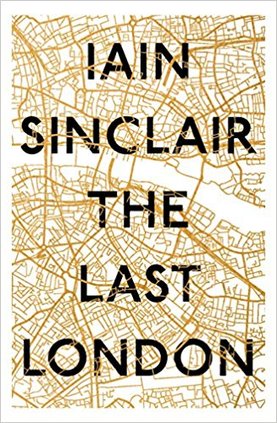
As the book approaches its conclusion, Sinclair is on the hoof again in pursuit of the next London, if indeed it exists. His walk from Gospel Oak to Barking in the company of (literally) ghostwritten friends who have gone, charts the path of the partially-electrified railway which will eventually spark life into the provisional community rising from the sedge and mud at Barking Riverside. There is a point on the journey where his narrative splinters - the narrator is no longer the walker as he pushes over boundaries and into sectors of the suburbs which are outside his experience. It's strange, and liberating as a long-time reader of Sinclair, to feel the author's raw response to the strangeness of this hinterland. He crosses the North Circular into Barking and recognises the kind of territory he used to occupy pushed out here to the margins, and soon to be pushed back further. He is spun back to Hackney in relief - that he has left Barking, or that places like Barking still exist?
The series of walks which are described in the final chapters of The Last London have another function - they detail those who will continue to walk and record. John Rogers, Andrew Kötting, Effie Paleologou - in words, film and images they have already long since taken up Sinclair's mantle. They walk beside him, and they'll carry on walking into their own Londons and beyond. Their work is generously referenced, openly admired. Their activism and vigour a match for the demands of the last London - their variations on Sinclair's themes spinning off into new territory, new media, new technology, but always anchored into a shared past. Thinking of the influence of Sinclair's now extensive body of London writing, I wince a little on reading my own over-egged thoughts here and see an homage to Sinclair in every description of a decommissioned facility or deleted franchise. The companions on these final walks are commended to us by Sinclair, not least for his appreciation of their ability to navigate the city in its current situation. They are doing what he can't now, receiving messages which are incompatible with his self-confessed duncephone. The book closes with a final pilgrimage - an account of the march from Waltham Abbey to St Leonards on Sea which morphed into Kötting's Edith Walks film - once again piercing the skin of the M25, out into the fractious hinterlands where 'Vote Leave' signs line the lanes. Out of the city, out of the UK, out of Europe. The uncertainty of the future weighs heavily on Sinclair, and he almost pines for the easier times under Thatcher when the needle on the national moral compass was inverted rather than spinning erratically. A time when satire didn't turn eagerly into newsprint with each dumb tweet from Donald Trump. It's down to these new walkers to make sense of the next London in a post-factual, digitally altered world. It would be a gloomy way to pass out of the city if it wasn't written with such vigour and precision - Sinclair is playfully pithy to the bitter end of his walk, enjoying the freedom perhaps of looking back on London?
The Last London is as ever an erudite, complex work which will have readers reaching for references and chasing down works by Sinclair's kindred spirits. It's not an easy read, but it rewards time and effort to untangle the threads of myth and modernism which wind around his map of the city, reaching out to his coastal redoubt. While it refers deeply into Sinclair's history of writing on London, it stands alone as a guidebook to future cities which exist everywhere and nowhere. Perhaps it also sounds a call to the next generation of pavement botherers, mythmakers and diviners of this ancient, ever-changing city. If they turn in an account half as vital and detailed as this, there is an interesting future in the written city.
You can read, and hear, a discussion between Iain Sinclair and John Rogers about The Last London at The Lost Byway.
The second half of the twentieth century was a rather remarkable time in Britain. All of the assumptions about town and country, the way of life which went on in each, and the kind of people who inhabited them were somewhat up-for-grabs for the first time since the Industrial Revolution. It was also a surprisingly exciting time for planners and architects, professions who rarely enter the general public discourse except when they do something very wrong indeed. The massive destruction of city centres in the second world war, coupled with a municipal spirit which genuinely sought to improve conditions for the vast populations still effectively living in Victorian slums meant new responses to how people were housed and how their needs were met. In fact, for perhaps the first time since the pioneering efforts of industrialists like Titus Salt or Lord Leverhulme, the concept of placemaking - creating spaces deliberately to be inhabited - became a preoccupation for local and national government alike. In his second book broadly focusing on this period, John Grindrod has used one of the 'big ideas' of the era as a lens through which to view this period. Was this a golden age realised, or good intentions squandered? Through the course of Grindrod's own connection with the green belt around London he tries to determine the outcome.
John Grindrod did most of his growing up on the very edge of New Addington, where urban Croydon finally stops trying, and Surrey begins. He describes this edgeland world in fond but honest detail throughout Outskirts as he traces the thread of the idea of a green belt - initially around the ominously expanding fringe of post-war London. On his journey, Grindrod examines the origins of the idea in the Garden City movement who proposed the rigorous management of space and density within their tightly zoned new communities, and attempts to untangle the politics of planning for the swathes of unused and unusable land around our cities. One of his early discoveries, and a persistent theme throughout the book, is the lack of greenery in the green belt - while his own upbringing on the edge of the downs was relatively bucolic, the green belt elsewhere contains the kind of edgeland industries, waste management facilities and abandoned land which is probably depressingly familiar to drivers everywhere - and which not coincidentally fill the photo galleries of this blog! It soon appears that in fact, virtually anything can be built in the green belt once the requisite hoops have been jumped through - except housing. But of all the pervasive, permitted development which Grindrod finds, it is the golf course which is most prevalent. These cartoonishly green swathes of primped grass and fluttering flags litter the edges of our cities, destroying the very ancient countryside which the zones would seem to be designed to protect. Of all the promises of Class War which the late 1970s seemed pregnant with, it seems it's the war of the golfing versus non-golfing middle classes which is playing out even now on the edgelands!
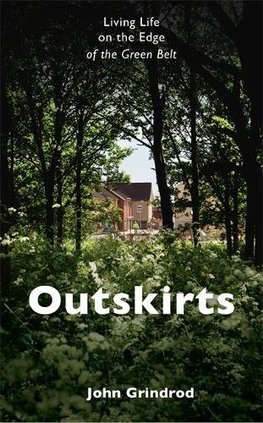
And this leads to another revelation for Grindrod - that the green belt has very little to do with protecting the countryside, and everything to do with protecting life in the city. The designated swathes of space, by the 1960s enveloping many English towns and cities, aimed to check the growth of the towns and to preserve the distinct identities of places which otherwise threatened to merge. The green belt was also where the overspill towns would be placed - those new towns which would house the displaced from the rezoned and yet-to-be revitalised city centres. These towns were rarely entirely new - often co-opting existing communities like Old Harlow or the villages around what is now Milton Keynes - but their position squarely within the belt allowed total control over their growth, their zoning and their density. I grew up amidst one of the later phases of the New Towns programme - in Redditch, Worcestershire - which suffered greatly when the programme was finally cancelled in the 1970s before much of the work was complete. Among the gravel-covered empty lots redesignated as pay-and-display carparks, one redeeming feature of the plan was the swathe of greenery which one needed to cross to get to Birmingham. From my earliest interest in maps and roads, I understood that the town and the city were never to meet.
This could all be another dry examination of the successes and mishits of planning policy but for two things: firstly, John Grindrod writes with a wit and clarity which turns a wander through the wooded edges of Croydon into a minor epic, and a trek through the history of planning into a historical romance. His tackling of the social and political themes from which the green belt arises are sensitive and give appropriate credence to the tenor of the times. We'd never accept such paternalistic interference nowadays of course, in this post-expert era of history - but Grindrod manages to put us back in the shoes of those principled and ambitious post-war planners who really wanted to create a new Britain from the ashes. Secondly, the story is riven by an autobiographical strand which describes a family life that many of us who grew up at that time will recognise - the social engagements, the attitudes and expectations, and the pressures of being young and different were certainly not lost on me. The relationship of family, place and policy somehow came to a head in those years during the 60s and 70s when anything seemed possible despite only having four TV channels and living miles from anywhere.
Outskirts manages to be a funny, affectingly personal history of life in a particular setting at a particular time, whilst successfully unravelling the decisions and policies which created that way of living. Once again, John Grindrod has chosen a topic which for many would seem unsympathetic and without interest, and turned it into a rather joyous book.
Somewhere in the chaos and confusion of elections, referenda, terrorist attacks and transatlantic tumult in the last several years, HS2 has all but disappeared from the debate. This emblem of a modern Britain dragging itself towards the future was to scythe across green and pleasant England, linking London and Birmingham in hitherto unimaginably short journey times. Despite being a tiny country, we would finally reap the benefits of High Speed rail as a way of linking the metropolis of London with first the rapidly gentrifying Midlands, then the Northern Powerhouse. Eventually, it might even reach Scotland - still in the political sin bin for daring to dream of independence. For a long time, HS2 dominated debate - and in an odd precursor of Brexit it wasn't entirely cut along party political lines either. An MPs proximity to the line or its potential termini was a far better predictor of their view than rosette colour. The massive task of taking a project like HS2 through public enquiries, select committees and detailed planning hearings began in earnest and as the detail came into mind-numbing focus, the big picture disappeared entirely. The hearings and enquiries were utterly public and transparent processes, but the cloak of technical complexity is always much more effective than outright secrecy. Objectors became well-versed in environmental impact assessment, cost benefit analysis and property law while the rest of us just had to decide if it all sounded like a 'good idea'. I confess I was broadly in favour at the outset: I love trains, I'm a committed user of public transport, and I enjoy seeing technology advance. But the zones through which the line would pass, once it left Greater London in particular were a near blank for me. It was easy to dismiss as cartographic whitespace.
Finding an urge to colour in these gaps, Tom Jeffreys achieves something quite remarkable in Signal Failure: bringing the massive complexity of HS2 back to a human scale. He sets out to walk the route, scribed in lurid highlighter strokes across Ordnance Survey maps as a not-entirely-inaccurate approximation of how the line's critics imagine the line was planned. It should take him ten days, involve some camping out in the wild and bring him into contact with all kinds of characters who sit on the frontline of the debate along the way. It ends up being a far more complex proposition which examines the very nature of walking itself before Jeffreys finally reaches the Bull Ring.
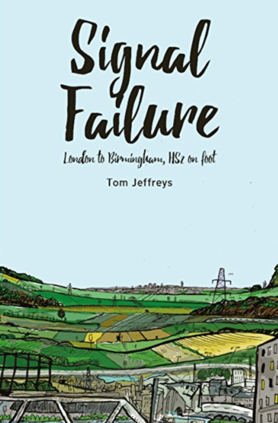
Jeffreys is by trade a writer on art, and brings with him from that world two absolute gifts: an eye for beautiful descriptive detail which makes the waste incinerator at Calvert sound a sublime almost-equal to any view across the Chilterns, and genuine erudition which underpins his writing with detail and research. This is a surprisingly hefty book, and in the early passages where the nature of walking writers - and writing walkers - is examined, I started to feel concerned that this had backed things into a niche. However, these reflective essays are punctured by reality - errant horses, the hardships of camping, the treacherous nature of industrial cartography - which anchors them in a quest. A quest which Jeffreys self-deprecatingly feels he ultimately fails to achieve - but in unravelling the journey he introduces people who's experiences take HS2 from a conceptual diagram towards a future reality. There are the couple who didn't realise how desperate and suicidal the prospect of the line made each of them feel until they were interviewed on camera together, there is a naturalist who stands to see preciously guarded habitat riven by rails, and there is a cheesemaker who has been through this before: embracing change, diversifying to survive, revisiting the business model. Jeffreys' encounters with the wider public are perhaps more like my own when walking: suspicious, confused, somehow irritated that someone is stepping outside the normal boundaries. The walking writer is a figure of deep apprehension these days, and sometimes perhaps deservedly so.
Throughout the book, Jeffreys wonders about what he is writing - glancing off psychogeography but landing squarely between travel and nature writing on the shelf. The debate that squirms at the core of the book about nature, wilderness and human intervention finds its feet in the examination of these genre politics and I found myself genuinely intrigued by the history of older, extremely white men batting the future of the planet back and forth at length. It's important to remember to that these are, in principle at least, the people who agree we should act swiftly to save the planet! For his own part Jeffreys is, rather like me, not the kind of person who can name our flora or fauna, or who knows what's good to eat and what will kill you out there in the wilds - but his engagement with the kind of spaces we all experience, every day is challenging and inspiring.
Signal Failure is an impressive achievement - taking the walk and exploring not just the landscape and its people, but the theoretical underpinnings of grand projects like HS2 and their human and natural impact - but in a way which places us in a landscape from which we don't fully understand what we'll lose.
Lost::MikeGTN
I've had a home on the web for more years than I care to remember, and a few kind souls persuade me it's worth persisting with keeping it updated. This current incarnation of the site is centred around the blog posts which began back in 1999 as 'the daylog' and continued through my travels and tribulations during the following years.
I don't get out and about nearly as much these days, but I do try to record significant events and trips for posterity. You may also have arrived here by following the trail to my former music blog Songs Heard On Fast Trains. That content is preserved here too.
